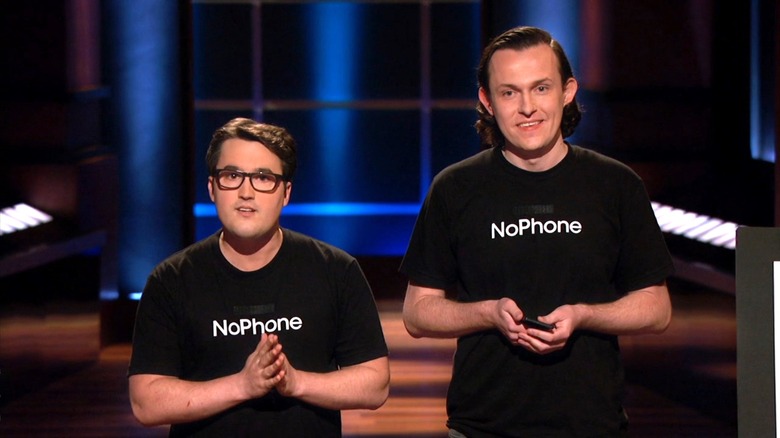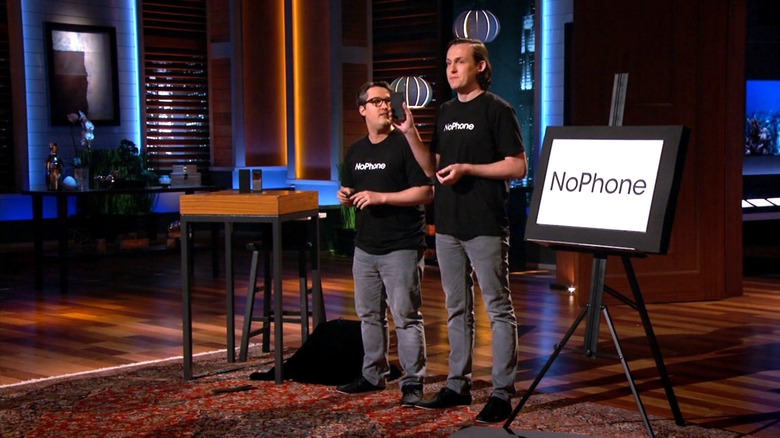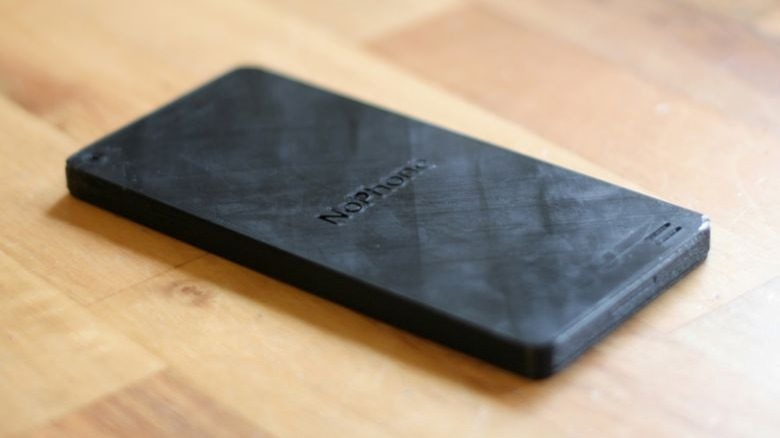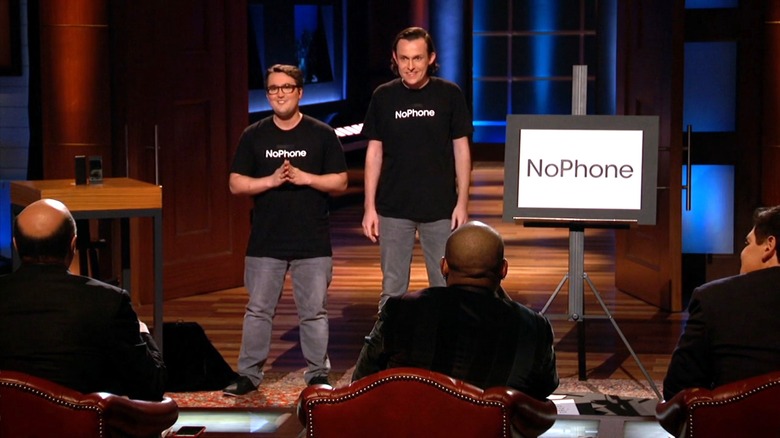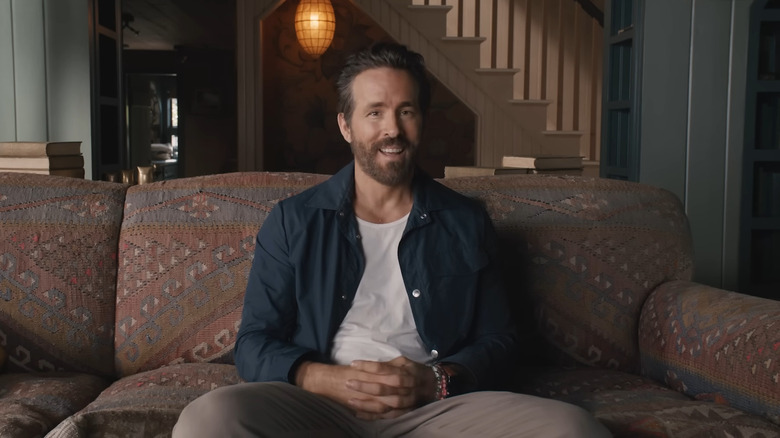What Happened To NoPhone From Shark Tank Season 7?
We may receive a commission on purchases made from links.
It doesn't happen often, but every once in a while, the Sharks will hear a pitch so awful or perplexing that they think they're being pranked. Granted, there's some merit to what entrepreneurs Van Gould and Chris Sheldon were trying to convey, which may be why the Sharks even entertained hearing more about NoPhone, the "pet rock" of the 21st century, but the duo had an uphill battle in convincing the titular investors.
Being a new pet rock definitely isn't a death knell, especially since creator Gary Dahl became a millionaire off the simple idea. Can the same be said for Gould and Sheldon, though? Or did they flop out of the tank like other notable "Shark Tank" failures, such as the Sullivan Generator from Season 3 or the Kymera body boards from Season 10? Gould and Sheldon entered the tank with a block of plastic and a vision, but as "Shark Tank" fanatics know, more is needed to win over the money-loving investors.
What happened to NoPhone on Shark Tank?
Van Gould and Chris Sheldon stepped into the "Shark Tank" in an unusual way that already had the Sharks on edge — seemingly distracted by their mobile devices. Of course, it was all part of the gimmick to portray the global obsession with smartphones, which, as Gould explains, they first noticed while at a bar.
They then revealed their product — a simple hunk of plastic that resembles a phone — and explained it was meant to help people battle their phone addictions and resist the urge to text and scroll. While the Sharks clearly found this humorous, Gould and Sheldon faced an uphill battle to convince any of the five investors to part with $250,000 for 25% of a product that they, themselves, described as being "not intended to be used for anything." The duo was given the opportunity to tout their $42,000 in sales, and while that figure surprised the Sharks, the pitch took a turn when Daymond John asked if there was a patent. When they affirmed that they did apply for a provisional patent, Mark Cuban immediately dropped out, stating, "There's only one thing I hate more than people staring at their phones, and that's dumb patents."
From there, the rest of the dominos fell. Though Robert Herjavec admitted the idea was clever, he showed concerns over the growth opportunity and bowed out. John, Lori Greiner, and Kevin O'Leary were blunter as they backed out, with the latter calling the product "nothing," effectively ending the pitch.
NoPhone after Shark Tank
Van Gould and Chris Sheldon may not have earned the trust and money of any Shark, but that's not always the end of the line for a product. Despite bombing on TV, NoPhone persisted and attempted four different Kickstarter campaigns. Though the first campaign in 2014 sought $30,000 and only raised $10,021, the pair tried again twice in 2015.
The second campaign sought $5,000 and raised just over $18,000 to back the model NoPhone presented on "Shark Tank." The third Kickstarter for the NoPhone ZERO, an even more basic iteration with engraved branding, sought $500 and raised over $1,200. Finally, in 2016, Gould and Sheldon ran a campaign for the NoPhone Air, clearly embracing the gag concept with a plastic shell full of nothing. While previous Kickstarters smashed past their goals, the NoPhone Air barely made the $500 goal with $563 pledged.
While the focus seemed to be on Kickstarter, NoPhone was popping up all over the place. Local news stations across the globe and publications like The New York Times and FastCompany covered the NoPhone, and co-creators Ben Langeveld and Ingmar Larsen even hosted TEDx Talks about the concept behind a phone that does nothing.
According to Langeveld's personal website, NoPhone shipped over 10,000 phones "to date," though there's no indication of a timeframe.
Is NoPhone still in business?
Van Gould, Chris Sheldon, Ben Langeveld, and Ingmar Larsen may have continued pushing NoPhone after "Shark Tank," but it's difficult to determine what levels of success the company has found in the years following their TV appearance. All virality dropped off a long time ago, and the most recent social media activity appears to be from 2021 on the company's X, formally known as Twitter, account.
However, if you visit the mock phone's website, you can see that the original NoPhone is going for $15. You can order one without packaging for $13, or you can splurge a bit and spend $70 for a pack of five. There's also the NoPhone with the selfie upgrade, a stick-on mirror, that goes for $22. It's worth noting, however, that the only product listed on The NoPhone's Amazon brand page is a t-shirt.
On LinkedIn, both Gould and Sheldon have updated their work experience to include time spent at a company called Anomaly from 2020 to 2021 and, more recently, Maximum Effort from 2021 to the present. Additionally, while Sheldon still has NoPhone listed as present work experience, Gould added an end date of November 2021 to his profile. Similarly, Langeveld's LinkedIn reveals that he left the company in 2022.
What are the NoPhone founders doing after Shark Tank?
NoPhone may be in the rearview mirror for Chris Sheldon and Van Gould, but according to their socials, they are actively working at Maximum Effort as creative directors. According to Maximum Effort's About page, the company is focused on producing content "for the personal amusement of Hollywood Star Ryan Reynolds."
Based on the projects listed on the official website, it seems Maximum Effort is behind advertisements and quick videos for Reynolds' movies and business ventures. For example, there are videos promoting Reynold's companies Mint Mobile and Aviation American Gin, as well as promoting "Deadpool & Wolverine." As for Ben Langeveld, he currently works as the creative director at consulting agency Treffend & Co., and Ingmar Larsen remains at NoPhone while also having founded the advertising company This Agency.
If one thing is clear, even if it is defunct today, NoPhone survived quite a bit after its appearance on "Shark Tank," which is surprising, considering it really was just a thin plastic rectangle with no actual purpose. Of course, this wasn't the only-phone related product to ever make its way onto "Shark Tank," and if you want to learn about more tech-savvy pitches, then read about the Flipstik from Season 12 or the Banana Phone from Season 14.
"Shark Tank" is available for purchase on Prime Video.
